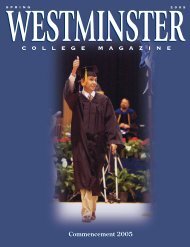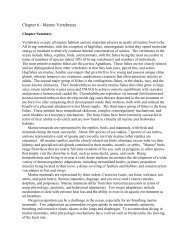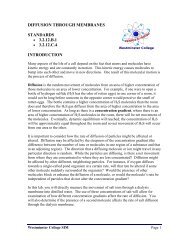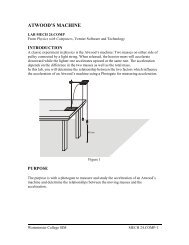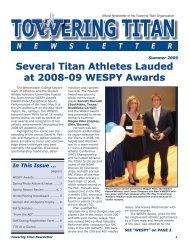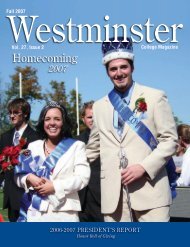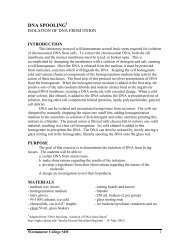Sporting Life - Westminster College
Sporting Life - Westminster College
Sporting Life - Westminster College
You also want an ePaper? Increase the reach of your titles
YUMPU automatically turns print PDFs into web optimized ePapers that Google loves.
www.westminster.eduThis goal will be met through the installationof a compact shelving system in the basementperiodicals room and in an adjacent area,which will increase the collection capacityby the approximately 33 percent neededfor an institution of <strong>Westminster</strong>’s size andacademic quality. The compact shelving unitsslide together when not in use (providing muchmore capacity than fixed shelving in a givenfloor area) while still maintaining easy accessto library materials. A reinforced floor will beinstalled to accommodate greatly increasedfloor loads associated with these systems.Community Use: McGill Library is distinctivein that it serves as an academic library and acommunity library. A popular children’s roomhas existed since its 1937 construction, and a“community bookshelf” was added in 1976 as abicentennial project supported by several civicgroups. The construction of the Shenango-onthe-Greenassisted living complex across thestreet and new condominium developments(primarily for seniors) nearby have increasedpublic use of McGill Library considerably.Public use will be enhanced by therefurbishment of the children’s room and thecommunity reading room. The computer labwill also be refurbished and equipped withmultimedia technology for educational andcommunity use. Additional public displaysof <strong>Westminster</strong>’s collection of Egyptian,Middle Eastern, and Asian artifacts may alsobe developed.Reconfigured Study/Learning Space:Traditionally, libraries have been designed andfurnished to meet the needs of an individualscholar working alone in a quiet environment.Today, however, there is an increasedemphasis on class or group projects requiringcollaboration and sharing of resources.This need will be met by creating a newseminar room on the first floor, refurbishing thesecond-floor group study rooms, refurnishingthe architecturally-striking domed FergusonRoom and the adjacent literature roomwith more flexible seating arrangementsthat facilitate group work, and generallycreating a more “open” library with flexibleaccommodations for individual study andcollaboration.Accessibility: As with most older buildings,McGill Library needs to be made moreaccessible to individuals with disabilities.Improvements will include the rampingand reopening of the library’s original 1937entrance, construction of new first-floorrestrooms, refitting existing restrooms, andthe installation of a new, larger elevator. TheseReconfiguring study/learning spaces andincreasing collectioncapacity willbe major componentsof the McGillLibrary renovation.Other improvementsinclude increasedaccessibility, infrastructureupgradesand general aesthetics.Public use ofthe library will alsobenefit from refurbishedcommunityand children’s areas.improvements will result in a more attractive,user-friendly facility that is fully accessible.Infrastructure: Existing systems need to beupgraded, and new requirements met.Infrastructure improvements will include theinstallation of a sprinkler system in corridorsand other access areas and new fire alarms forfire safety, ventilation/heating improvementsand window refurbishment to enhance usercomfort and energy efficiency, electricalupgrades, and roof/masonry repairs.Aesthetics: A general refurbishment will resultin an attractive, up-to-date facility that retainsits historic character and features.This work will include refurbishing themain-floor lobby area (including a newcirculation desk), rebuilding the deterioratingvaulted ceiling in the second-floor FergusonRoom, and general aesthetic improvementsthroughout.Library technology enhancements havealready been completed with the installationof a new collection management system andpublic access computers (funded by a $100,000grant from the federal Institute of Museum andLibrary Services) and building-wide, wirelessInternet connectivity supported by a $15,000gift from the Class of 1953.Project planning and fund raising are nowunder way. To minimize disruption of academicprograms, construction will take place over thesummers of 2007 and 2008 with renovationscompleted for the opening of the fall 2008semester.“We urge everyone to support this importantproject,” concluded Williamson, “and we lookforward to keeping you informed about itsprogress.”McGill Library VolunteerGroup Aims to Meet$2 Million ChallengeThe McGill Library project is off to agreat start, thanks to a $1 million anonymousdonor challenge and the support ofan enthusiastic group of volunteers determinedto meet the challenge by raising $1million or more in gifts and pledges overthe next 18 months.A kick-off luncheon was held on December5 in the Witherspoon LakeviewRoom of the McKelvey Campus Center,where volunteers learned more about theproject from Gloria Cagigas, vice presidentof institutional advancement, andMolly Spinney ’72, head librarian.Volunteers include: Richard Barnhart’55, Matthew Hosie ’49, Jean SwindlerHosie ’50, Darwin Huey ’74, Sally KeenerHuey ’74, Mary Louise Gettemy Ireland’45, Glenn Morris ’53, LarryVerone ’53 and Janet WilsonVerone ’53. Dorothy Pollock’46 serves as the coordinatorfor volunteer activities. Volunteersbegin their worklater this spring.Mabel Kocher ’32,associate professor andlibrarian emerita, servesas McGill Library projectvolunteer chair. Mabel’sassociation withMcGill Library spansmore than 63 years.Winte r 20 06 • Wes tminste r C ollege Magazine13



